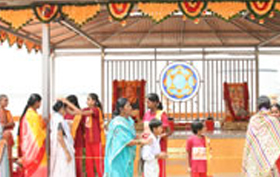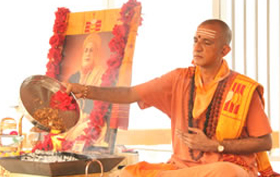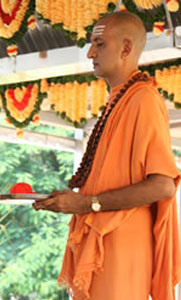
As the supporter of all beings Narayana is also the source of the rain. According to the ancient texts, rain is evolved by the sun and the sun is sustained by Dhruva. Dhruva is supported by love of Lord Narayana, eternally existent Lord seated in the heart. On Dhruva rests the seven planets, and upon the planets depend the clouds. The rains are suspended in the clouds and rain is the nourishment and delight of all beings, gods, humans, animals and plants alike.
The water which falls as rain is the means of maintaining life. Water is the element which sustains and nurtures and likewise Narayana is the force which pervades, sustains and protects all creation. It is no coincidence that the presence and appearance of the water element permeated the events of the yajna indicating auspiciousness and divine blessings.

On the first day of the yajna, the murtis of Lakshmi and Narayan were brought in ceremonial procession to the place of yajna. As the procession began, from out of the clear blue skys, raindrops began to fall, not everywhere, but only upon the figures of the Lakshmi and Narayana as they made their way to the yajna area. In the Vishnu Purana the different types of rain are categorized. The rain which falls whilst the sun is shining and without a cloud in the sky is said to be the water of the heavenly Ganga, shed by the solar rays in blessing and benediction. Those who are touched by this pure rain, are cleansed from the soil of samsara, purified and blessed by this celestial ablution. Later the same day, in the afternoon the fire of the yajna was kindled. Although there had been no clouds in the sky previously, at the exact moment of lighting the fire, the rain began as Narayana gave his blessings for the success of the yajna.
After the installation of Lakshmi and Narayan with mantras and ritual worship was completed, an eagle flew above the three stages of the yajna, circling three times in a parikrama of respect before alighting in a peepal tree. Not only is the eagle the form of Garuda, the vehicle of Narayana, but the peepal tree is also much revered in India as the tree chosen by Lord Krishna to be one of his forms in the manifest world.
On the last day of the yajna, again there was not a cloud in the sky. At 1.30pm the pandits entered Akhara to perform the final puja of Lakshmi in the form of the Sri Yantra and Narayana in the form of Guru. Just as they entered the grounds, the raindrops began to fall while the sun was still shining brightly. The rain fell only in Akhara. Not on the path outside, nor the gardens and grounds opposite. The rain fell only on the area of the three Peeths and on the pandits walking to begin the puja.

Beloved of Lord Narayana is Tulsi and no worship of him is complete without her. In the scriptures it is said that Naryana takes up abode in the village or the house where Tulsi is grown. In such a house no one suffers calamities like poverty, illness or separation. Tulsi is auspicious in all respects. Simply by seeing or touching her, praying and bowing before her, or even by remembering or hearing about her, there is auspiciousness. Anyone who comes in contact with her lives eternally in the Vaikuntha world.
A special ritual of the yajna was the Sahasarachan conducted by the offering of tulsi leaves during the chanting of the thousand names of Vishnu and Lakshmi. It is said that even offering flowers made of gold, jewels and pearls do not have one sixteenth of the importance of Tulsi. These tulsi leaves were given to all as prasad of the yajna, but such was the spiritual force which with these leaves were charged, that Swamiji himself gave an instruction that the leaves should be placed on the puja altar in each home overnight, so that the auspicious grace and benevolence of Lord Narayana could pervade every house in Munger.

Although the yajna was not formally announced to the public, the participants numbered over two thousand, which was unprecedented. Every day during the time of the sahasarachan, the prasad of the yajna was distributed to all present, the local devotees, sannyasins, national and international guests alike. As the mantras were chanted the endless line of recipients made a parikrama of the stage and yajna area, receiving the darshan of the Lord and his Sri, and the blessings of Swami Niranjan for their peace, plenty and prosperity in life.
The program was flawlessly managed by the children of Bal Yoga Mitra Mandal, the gracious hosts of the first yajna in Munger, who with smiles of welcome gave tikka to all who entered the yajna grounds, saw to the seating of guests, distributed prasad, and made all the program announcements. The kirtans sung by the children were spectacular show stoppers that had everyone dancing in joy and brought tears of love and devotion to the eyes.

In the midst of it all, Swami Niranjan was always present. From morning to night his smile was radiant as he met and conversed with guests. Untiringly he attended to the requests and pleas of devotees with kindness and compassion. The day was interspersed with his satsangs and penetrating insight into spiritual life, bhakti and upasana. Every single item of the program was orchestrated under his watchful eye and guidance. Each day, morning and afternoon without fail, he would enter the pandal and walk through the audience, greeting participants and giving everyone an opportunity to have his darshan. As he moved about, waves of devotion swelled like an incoming tide of love that followed in his wake. If Sri Swamiji is the King of Hearts, it is only natural that his chosen son would be our Prince of Hearts.

Paduka Darshan sits beside the Ganga, the sacred stream that washes away all ignorance and impurity, considered to have come from the toe of the Lord himself. In ancient times Lord Narayana assumed the form of a dwarf child Vamana, to defeat the powerful Vali. He appeared at the yajna and Vali, being so taken by this radiant child dwarf, insisted that he ask for a boon. Vamana replied that he wanted nothing other than the land covered by three of his steps. Vali agreed.
But the first step taken by Lord Narayan in his dwarf avatar covered the whole of patala, the underlands, his second step engulfed the entire earth and his final step reached the heavens. While taking his last step, the toes of the left foot of the Lord pierced the brahmanda, and through the hole created, the celestial river Bhagavati Ganga began her descent to earth. She fell firstly on the top of the heavens, where Dhruva sits, engrossed in the vision of the lotus feet of Narayan in his heart. Here the saptarishis, the seven sages of unsurmountable wisdom, honour and worship her with the highest reverence and devotion, as she begins her descent from the abode of Vishnu, through the lokas to finally be caught and forever embraced in the matted locks on the head of Lord Siva before gracing the earth.

Ganga is a celestial conduit between the heavens and earth and her very presence brings the blessings of Lord Narayana and all enlightened beings. For this reason ages and saints have always based themselves alongside her and it is said that sadhana done beside her waters will always be successful.
To propitiate the cosmic shakti Durga and seek her grace and blessings for the future work of Sannyasa Peeth and the successful fruition of his Guru’s mandate, Swami Niranjan undertook a year long anusthana which began on January 2nd. This anusthana continued through the yajna and all participants were able to participate in this historical event.
Each day began with an unforgettable glimpse of higher spiritual existence, the worship of Guru and the Durgasahasranamavali havan conducted by Swami Niranjan himself. During each havan the thousand names of the Mother were chanted three times, making a total of three thousand names and three thousand offerings to the fire. The location was perfectly suited to the worship of prakriti, the cosmic creatrix. All five elements were present – the yajna fire, flowing water, green grass covering the earth, blue skies and the open expanse of space and reverberating with the vibration of mantra. The powerful and the protective presence of Devi could be felt by one and all.

As the sun reflected off her waters and the mantras permeated the environment, the presence of Ganga was like that of a celestial mother sharing her blessings and benediction with all her children. It was as if the entire event was taking place in her lap and she was watching every moment. “I am the river, you are the sea, let your love flow through me” were the lines to a song sung by the children of Bal Yoga Mitra Mandal during the yajna that beautifully captured the yearning of the individual self to find the higher consciousness. When the river merges with the sea, the water loses any distinction between river and ocean. When the identity is lost in divinity all that remains is the expression of that transcendental and divine love. The form of god and guru is love and the connection with that love is maintained in the heart through belief, faith and devotion.

On the first and the last days of the yajna, a special darshan was given. While the pandits were invoking the yajna agni on the first day and during the poornahuti of the last day of the Mahayajna, two deer were seen walking on the banks of the Ganga. Deer have never been found in Munger and there is no explanation for their sudden appearance. Whether the deer were the manifest form of Lakshmi and Narayana, or whether it was Swami Sivananda and Sri Swamiji no one can say. But an indication as to the significance of the darshan is there. The deer is the symbol of the anahata chakra, the abode of the heart, the cosmic experience and power of divine love.
Whether expressed by the transcendental bond between Guru and disciple, or the illumined compassion of siddhas and saints, the pure and devoted love of Tulsi, the eternal duality of Lakshmi and Narayana, the steadfast devotion of Dhruva, or the simple yearning of the individual heart for the divine, the theme of the yajna was love. Filled with signs of blessings and grace, the Lakshmi Narayan Mahayajna was like a pure, sweet current of love which flowed between the individual and the divine and filled the hearts of all.
Finally the message was simple. The Lord lives within your own heart. Open your heart and find him.
